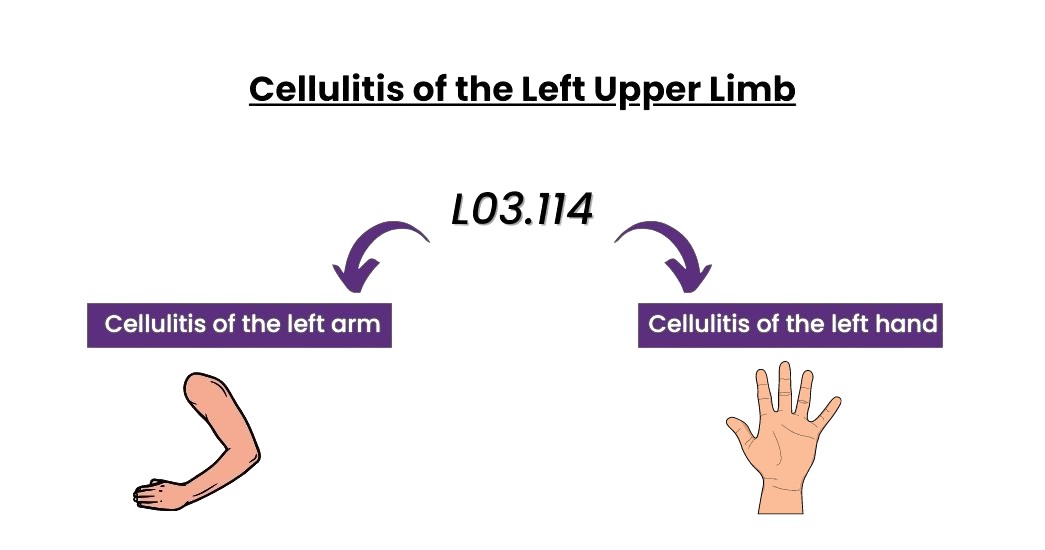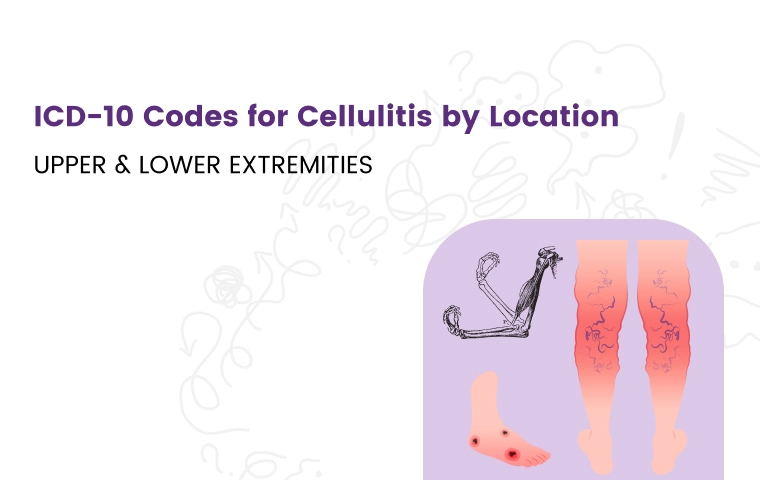Cellulitis, with its varying degrees of severity and location on the body, presents a unique challenge for medical billers and coders. The specificity of ICD-10 codes demands a thorough understanding of the infection's nuances, from the affected body part to the presence of complications.
This definitive guide will walk you through icd 10 code for cellulitis for each type, providing clear explanations, examples, and expert tips to ensure accurate and efficient coding practices. Whether you're a seasoned coder or new to the field, this guide will become your go-to resource for mastering cellulitis ICD-10 codes.
What is Cellulitis?
Cellulitis is a common, potentially serious bacterial skin infection. It affects the deeper layers of the skin, including the dermis and subcutaneous tissue. The infection usually occurs when bacteria, most commonly streptococcus and staphylococcus, enter the skin through a break or crack.
Key Characteristics:
Appearance: The affected area appears red, swollen, and feels warm and tender to the touch. The edges of the redness may not be well-defined, and the skin may have a dimpled appearance.
Symptoms: Pain, tenderness, and a general feeling of unwellness are common symptoms. In severe cases, fever, chills, and swollen lymph nodes may also occur.
Location: Cellulitis can develop anywhere on the body but is most common in the lower legs.
Risk Factors: Conditions that compromise skin integrity, such as cuts, ulcers, athlete's foot, and eczema, increase the risk of cellulitis. People with weakened immune systems are also more susceptible.
Cellulitis Location-Specific ICD-10 Codes
Cellulitis doesn't discriminate; it can affect any area of the body. That's why ICD-10 coding for this condition is highly specific, based on the exact location of the infection. This section dives into the essential codes for accurate billing, organized by body region, ensuring your claims reflect the precise nature of each case.
Cellulitis of the Left Upper Limb
When cellulitis strikes the left upper limb, accuracy in ICD-10 coding becomes paramount. The codes ensure proper documentation and reimbursement while also contributing to a broader understanding of this prevalent condition.
L03.114 is the correct and comprehensive ICD-10 code for cellulitis affecting the left upper limb. This includes:

-
Cellulitis of the left arm: Whether it's the upper arm, forearm, or wrist, L03.114 covers all areas of the left arm.
-
Cellulitis of the left hand: This includes the back of the hand, the palm, and the fingers.
ICD-10 Codes for Cellulitis of the Left Finger
Cellulitis affecting the fingers requires specific ICD-10 codes to accurately reflect the location of the infection. The L03.01- code series allows for this precise documentation. L03.012 is ICD 10 for Cellulitis of the left finger (This code is a general code for cellulitis of any finger on the left hand. Use this code if the documentation does not specify the exact finger.)
Cellulitis of the Right Upper Limb
L03.113 is used When cellulitis affects the right upper limb This code encompasses all areas of the right upper limb, including the right arm, right hand. Unlike broader areas like the arm or leg, where a single code suffices.L03.011 is a general code for cellulitis of the right finger.
Cellulitis of the Buttock
Cellulitis affecting the buttock region requires precise coding to ensure accurate claims and proper documentation. Unlike the limbs, where laterality (left or right) is often specified, cellulitis of the buttock has its own unique code.
Key ICD-10 Code:
-
L03.317: Cellulitis of buttock
This code is used regardless of whether the cellulitis affects the right or left buttock. It encompasses the entire gluteal region.
Cellulitis Bilateral Lower Extremities
When cellulitis affects the left lower limb, accurate coding requires a precise understanding of the affected area. The ICD-10-CM codes for this condition are
L03.116: Cellulitis of left lower limb
-
This code encompasses the entire left lower limb, including the left thigh, left leg, left ankle, and left foot.
Cellulitis of Toe
Cellulitis of the toe, whether on the right or left foot, necessitates specific ICD-10 coding to accurately represent the affected area. Unlike broader regions like the leg or foot, which have general codes, toe cellulitis requires precise identification of laterality (right or left).
This distinction is crucial for accurate medical billing and documentation, as it reflects the specific location of the infection and guides appropriate treatment decisions. While each individual toe has its own unique code, the fundamental differentiation lies in whether the cellulitis affects the right (L03.031) or left (L03.032) toe.
Facial Cellulitis
Facial cellulitis, a potentially serious infection of the skin on the face, demands precise ICD-10 coding.
L03.211: Cellulitis of face
This code encompasses cellulitis affecting any part of the face, including the cheeks, forehead, nose, eyelids, and chin. It is a specific code for facial cellulitis and does not require any additional modifiers.
Scenario When Cellulitis Is Unspecified
Instances where a definitive diagnosis or precise location of cellulitis may not be readily available. The code, L03.90 (Cellulitis, unspecified), serves as a safety net for situations where a more specific code cannot be applied.
When to Use L03.90:
-
Insufficient Documentation: If the medical record lacks details about the precise location of the cellulitis, or if the documentation is ambiguous, L03.90 may be the most appropriate code.
-
Multiple Sites: In some cases, cellulitis may affect multiple body areas without a clear primary site. If it's impossible to determine the predominant location, L03.90 can be used.
-
Early Stages: In the early stages of cellulitis, before the infection fully manifests, the exact location might not be easily identifiable. In such scenarios, L03.90 can serve as a temporary code until more specific information becomes available.
Wrapping Up
Cellulitis may be a common skin infection, but its ICD-10 coding demands a sharp eye for detail. Every case is unique, and accurate coding isn't just about ticking boxes – it's about telling the full story of each patient's infection, from its precise location to any complications.
By mastering these codes, medical billers and coders not only ensure accurate reimbursement but also contribute to a larger effort to track and understand this condition.Consider this guide your roadmap through the complexities of cellulitis ICD-10 coding, equipping you to champion both patients and healthcare professionals alike.
ABOUT AUTHOR

John Wick
As a blog writer with years of experience in the healthcare industry, I have got what it takes to write well-researched content that adds value for the audience. I am a curious individual by nature, driven by passion and I translate that into my writings. I aspire to be among the leading content writers in the world.
